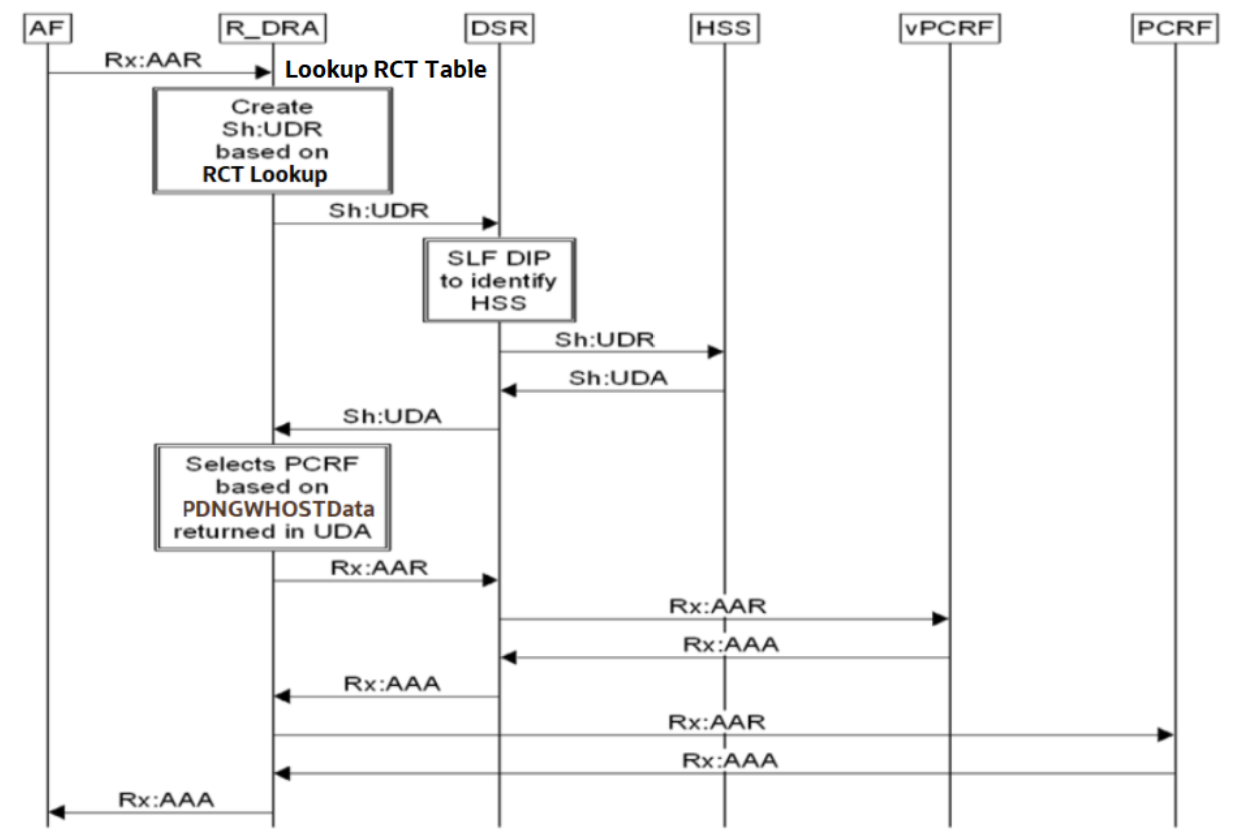Understanding RSA Functionality
RSA allows the operator to screen Rx Sh message at Roaming DRA .Oracle Roaming DRA (R-DRA) Virtual DSR establishes Diameter Rx connection with Oracle PCRF (PNF) segments. All vPCRF segments will be behind Oracle DSR (Core DRA/SLF) taking Gx, Rx, Sh, Sy traffic. R-DRA is the Virtual DSR deployed for Roaming use case. Core-DRA is the reference to Baremetal DSR running FABR use case
RSA process the messages for following use cases:
- Use Case A: Rx:AAR to Rx:Sh:UDR conversion (R:AAR messages converted
to Sh:UDR message based on RCT Look up table (DSA Config Table).
Figure 2-1 Use Case A: Rx AAR to Rx ShUDR conversion

- ART rule configured to route all Rx message to DCA Application (Rx ShUDR Application)
- New DCA Application Rx ShUDR Application receives all the Rx messages and checks for Rx AAR Initial (Rx-Request-Type AVP set to INITIAL_REQUEST) received at R-DRA in look up RCT table for Sh lookup.
- Every other Rx Request message received at R-DRA will lookup RCT table for Topology hiding. If Topology hiding is enabled for MCPTT Client, then look up THT table for pseudo FQDN to PCRF address is mapped. If any match is found, replace Dest Host as PCRF address and sends the message out for further routing. If match is not found, then the messages is forwarded for further default routing.
- Application will look up RCT Table based on incoming
origin-host AVP FQDN value. If Sh lookup required is Yes,
originated Rx:AAR converts to Sh:UDR message and is sent
out for further routing. Sh :UDR message contains:
- Session-Id> - To be assigned by DSR (copied from AAR)
- {Auth-Session-State} - NO_STATE_MAINTAINED value 1
- {Origin-Host} – DSR host-id, as it is the originator of the Sh:UDR (filled through Configuration Table)
- {Origin-Realm} – DSR realm, as it is the originator of the Sh:UDR ( filled through Configuration Table)
- {Route-record} – To be filled with peer FQDN value
- {User-Identity} – : filled with Subscription-Id AVP
value received in Rx:AAR message
- Subscription-Id Type 0 -- MSISDN/END_USER_E164 -MSISDN goes in User-Identity[MSISDN]
- Subscription-Id Type 1 -- IMSI - Goes into [Public-Identity]
- Subscription-Id Type 2 -- END_USER_SIP_URI - Goes into [Public-Identity]
- *{Data-Reference} – RepositoryData value as 0
- {Destination-Realm} – To be Assigned by DSR from Rx-AAR.
- ServiceIndication = Called-Station-Id (copied from AAR message)
- Sh:UDR sent out to DRL for further routing to core-DRA.
- Core-DRA perform FABR lookup based on IMSI/MSIDN and route to corresponding HSS.
- HSS process the Sh:UDR and sends back Sh:UDA to core DRA with PDNGWHOSTData data in UserData AVP.
- Core DRA route Sh:UDA to R-DRA which further route to Rx ShUDR Application based on ART route.(ART rule: Sh:UDR/UDA application messages route to Rx ShUDR Application DCA application)
- Rx ShUDR application process the Sh:UDA answer message and create/modify the Rx:AAR message (which is stored as cookies when first AAR message is received) with lookup the PDNGWHOST in PPMTTable and get the PCRF FQDN, sets Dest Host as PCRF FQDN and sends it out for further routing.
- PCRF sends back the Rx:AAA with PCRF Address as Origin Host.
- Rx-ShUDR application process the Rx:AAA message as answer message and create/modify the RX:AAA message with lookup in RCT Table and verifies if Topology Hiding is required or not.
- If Topology hiding required is Yes for Rx Client then search THT table (using PCRF FQDN present in origin Host ), replaces the original origin Host with pseudo FQDN from THT Table and sends it to DRL for routing to Rx Client.
- Rx client uses Pseudo FQDN as Dest-Host for future diameter transactions. New DCA Application Rx ShUDR Application receive messages other than Rx AAR Initial (Rx-Request-Type AVP set to INITIAL_REQUEST) will lookup RCT table for Topology hiding. If Topology hiding is enabled for origin host, then look up THT table for pseudo FQDN to PCRF address is mapped. If any match is found then replace Dest Host as PCRF address and sends out for further routing. If match is not found, then the message is forwarded as is for further routing.
- Use Case B: Rx-AAR -> RBAR lookup -> PCRF
- If Sh lookup required is No forward the message as is to DRL for further routing using RBAR lookup.
- RBAR Application look up in RBAR table only for Rx AAR Initial (Rx-Request-Type AVP set to INITIAL_REQUEST),select the PCRF based on Framed IPv6 prefix and sends to DRL for further routing (either directly or through Core DRA).
- PCRF installs desired policy and sends back Rx:AAA (with PCRF as Origin Host) to R-DRA (directly or through Core DRA).
- PCRF sends back the Rx:AAA with PCRF Address as Origin Host.
Figure 2-2 Use Case B

- Rx ShUDR Application processes the Rx:AAA message as answer message and create/modify the RX:AAA message with lookup in RCT Table and verifies if Topology hiding is required.
- If Topology hiding is required for Rx Client FQDN(), then search THT table (using PCRF FQDN present in origin Host), replace the original origin Host with pseudo FQDN from THT Table and sends it to DRL for further routing to Rx Client.
- Rx client uses Pseudo FQDN as Dest-Host for future diameter transactions, Rx-ShUDR Application receives message other than Rx AAR Initial (Rx-Request-Type AVP set to INITIAL_REQUEST) will lookup RCT table for Topology hiding. If Topology hiding is enabled for origin host, then look up THT table for pseudo FQDN to PCRF address mapping. If match is found, then replace Dest Host as PCRF address and sends out for further routing. If match is not found then forward message as is for further default routing.